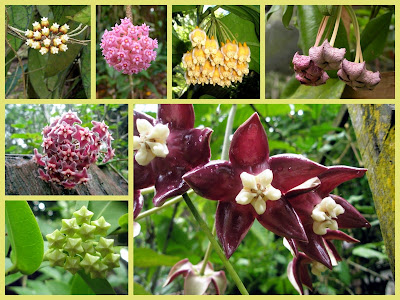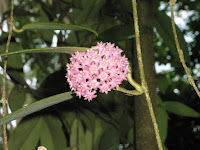 Hoya - an odd name, isn't it? But for some reason I find it a particularly attractive name for a species of flower. And at the Sabah Agriculture Park in Tenom there is a hoya garden which generally has a few varieties of hoya in flower. If you look carefully, you'll find them in the native orchid garden as well.
Hoya - an odd name, isn't it? But for some reason I find it a particularly attractive name for a species of flower. And at the Sabah Agriculture Park in Tenom there is a hoya garden which generally has a few varieties of hoya in flower. If you look carefully, you'll find them in the native orchid garden as well. Imagine my delight, then, to actually see the flowers! They are simply wonderful. Tiny massed spreads of star-like beauties in lots of different colours! Sometimes you are fortunate enough to see the really big (this is a relative comment!) purple one which is stunningly strong but generally the flowers are very small, often in unusual mixes of colours.
Imagine my delight, then, to actually see the flowers! They are simply wonderful. Tiny massed spreads of star-like beauties in lots of different colours! Sometimes you are fortunate enough to see the really big (this is a relative comment!) purple one which is stunningly strong but generally the flowers are very small, often in unusual mixes of colours. And when I found out that another name for these flowers is 'waxflower', it made complete sense, as the flowers are just as Wikipedia describes them: Each flower is about 1 cm diameter, with five thick, waxy, triangular petals; colours range from white to pink or yellow. They are sweetly scented and produce abundant nectar. I haven't noticed the sweet scent before - but will be sniffing for it next time. (Usually I'm too busy trying to get a decent picture as they are not easy to capture.)
And when I found out that another name for these flowers is 'waxflower', it made complete sense, as the flowers are just as Wikipedia describes them: Each flower is about 1 cm diameter, with five thick, waxy, triangular petals; colours range from white to pink or yellow. They are sweetly scented and produce abundant nectar. I haven't noticed the sweet scent before - but will be sniffing for it next time. (Usually I'm too busy trying to get a decent picture as they are not easy to capture.) Intriguingly, there is a whole list of odd words that goes along with this rather special plant that includes: umbellate and peduncles and glabrous! These are words that are worth eating, aren't they?
Intriguingly, there is a whole list of odd words that goes along with this rather special plant that includes: umbellate and peduncles and glabrous! These are words that are worth eating, aren't they?So, in Wikipedia, I learnt that the grouping of flowers is called an 'axillary umbellate cluster'. And where do they grow? Well, at the end of the peduncle, of course! And then what happens. according to Wikipedia: The flowering peduncles get 2-3 mm longer with each flowering, and can eventually reach 7 cm or more long... Gosh, I'm keeping my eyes open for a 7 cm peduncle!
 It's true that the flowers are shaped like 5-pointed stars and it's interesting to know that each group of flowers is called an umbel. Well, umbel - umbellate - umbrella? And an umbel can contain from 1 to 55 or more flowers!
It's true that the flowers are shaped like 5-pointed stars and it's interesting to know that each group of flowers is called an umbel. Well, umbel - umbellate - umbrella? And an umbel can contain from 1 to 55 or more flowers!But it's the description of the hoya flowers in Wikipedia that is a real hoot. Here it is: Hoya flowers vary in textures as well as size, some being glabrous and shiny and some being quite hairy... I had to check a dictionary for 'glabrous' and it means bald or hairless! I guess I have mostly seen glabrous hoya then. (You'll be able to talk like this when you're next looking at a hoya!)
 And you can let people know that the hoya is native to southern Asia, Australia and Polynesia!
And you can let people know that the hoya is native to southern Asia, Australia and Polynesia!Helen Morgan, Brenda Morgan and Jude Day took these photos.
If you have any comments or questions, please write to us. We'd love to hear from you on: ron@astsabah.com or jude@astsabah.com.




















